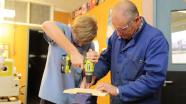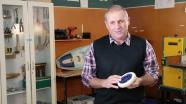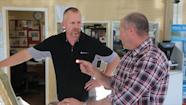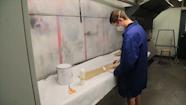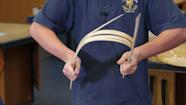Linking hands-on experiences and understandings
Hands-on experiences that allow the students to see materials understandings in action are central to technology teaching at St John's. Terry Mitchell, Steve Andrew, and their students show how making whistles from aluminium and from plastic provides a great context for discussing the properties of materials. Putting different kinds of materials in a bucket shows the students what happens to materials in this environment.
Duration: 03:54
Transcript
Terry Mitchell: Well at year 9 I like the approach as in we give the students materials and they can look at the materials, touch them and explore the properties of the materials. Without having to do a lot of theory work, they’ve got it in their hands, they can see what they are working with and see how they feel. Then they get to experiment with cutting and shaping and drilling and what they can do with those materials. For example our simple project at Year 9, making a Sheppard’s Whistle.
Student 1: Yeah when we first turned up at the start of the year the first project we started working on after the testing that we did was we started making some aluminium whistles, so that we could learn the properties of aluminium and how it’s bendy and how you can easily drill holes in it and manipulate it to be how you want it.
Student 2: We did the water bucket test. So we put it in and we judged it towards all the other materials that we had placed in the bucket.
Steve Andrew: Come and stand around here so you can see guys.
Student 2: Yeah it’s rusty, so...
Steve: So give us a mark, what do you reckon? 10 being good, 1 being no good.
Student 2: I think it’s a one and a half, zero.
Terry: And then they get to make the same whistle out of an acrylic, and they realise that although they are making the same product they have to use totally different techniques.
Student 2: We’ve made the two whistles out of the two different materials because well this one was just our first project and this one it’s a smoother feel in your mouth and it’s quite, and it feels comfortable in your mouth, as in this one it’s kind of cold and it kind of tastes metallic-y. And with this one it’s probably more cost effective because just of the material.
Steve: And what’s your slant on this one, what do you think that you’ve learnt out of this?
Student 1: So what we’ve done is we’ve learnt that the same thing can be made out of two materials, and that using a different material can sometimes improve a product that you’ve made. Like with the first one we made, we made the whistle and it worked, but if you got scratches in it, it will be harder to clean out properly, and it’s sometimes quite cold. Whereas with this one it is easy to clean, comfortable in your mouth and, yeah, works well as well.
Terry: What I enjoy about teaching technology this way is it’s teaching students to think that everything they do they have to have in their own minds clearly why they are doing it. And I think that’s the key is that they are always thinking why am I doing it this way, why am I using these materials to make this product. They, I think we’re teaching them to be problem solvers.
Student 1: The only thing with doing different materials though is you have to know the materials properties. Like with the aluminium all we needed to do was use the bender and just bend it, but with the Perspex we had to make sure that it was hot, so it was kind of melted and easy to bend.
Student 2: And as we drilled it before it was quite easy and smooth to drill the aluminium whistle, but with the Perspex whistle it was quite tough to drill, and also as Ryan says it’s quite hard to bend.
Terry: The kids really learn that these properties are core to what you have to know when you are making things.
Curriculum links
The structure of technology in the NZC
The video refers to strands and components within the technology curriculum. Follow the links below to read more about these aspects of technology.
View a diagram showing the structure of the strands and components within technology:
Read more about the strands and components Steve and Terry have been focusing on:
- The technological practice strand
- The technological knowledge strand
- The technological products component
Indicators of progression
The indicators of progression provide detailed information about what students need to be able to know and do in relation to the achievement objectives for technology.
Read the indicators of progression for levels one and two of the technological products component:
Reflective questions
- What opportunities do I give my students to learn that the same product can be made with different materials, and that different materials require different techniques?
- What opportunities do I give my students to explore the properties and characteristics of different materials?
- How am I teaching my students to think about the “why” of what they are doing – to be problem solvers?
Related resources
Student showcases
Incomplete prototype earns scholarship: A hockey bag required multiple materials. Read how the student evaluated a wide range of materials.
A WOW costume inspired by longhorn beetle: Many different materials were used in this costume – what were their names and properties?
More videos
Combining knowledge and practice
In this video Steve Andrew describes how focusing on technological products gives depth to technology teaching and learning at St John's.
Play, experiment, explore
Steve Andrew shares how and why he has the students see, feel, and play with products to develop their understandings in materials.
Finding materials to meet the specs
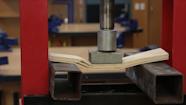

Steve Andrews shares how students identify material specifications in a brief and then test materials to find those that are suitable.
School–industry relationship cuts both ways
Steve Andrew and Terry Rillstone describe the way the relationship between St John's College and The Shop has benefits for them both.
Pushing the boundaries with materials
Steve Andrews describes how his senior students have the confidence to select and work with unfamiliar materials.
Exploring unfamiliar materials
Two year 12 students describe what they know about bamboo and how they are applying this knowledge to their projects.

